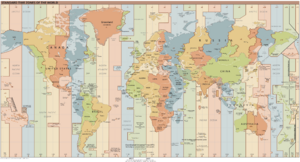Time zone facts for kids
Time zones are like invisible lines that divide the Earth into different areas, each with its own specific time of day. Imagine the Earth spinning like a top! As it turns, the sun shines on different parts, making it daytime in some places and nighttime in others. To keep track of this, we have 24 main time zones, one for each hour of the day. This helps everyone know what time it is, no matter where they are on the planet. For example, when it's morning in London, it's still the middle of the night in Los Angeles.
Contents
Why We Need Time Zones
Before time zones, every city used its own local time, usually based on when the sun was highest in the sky. This worked fine when people didn't travel much. But when railways became popular in the 1800s, people started moving quickly between cities. Imagine trying to catch a train when every town had a different time! It was very confusing.
To solve this problem, people realized they needed a standard way to tell time across large areas. This led to the idea of time zones, making travel and communication much easier and more organized. By the early 1900s, most places around the world had adopted standard time zones.
Greenwich Mean Time and UTC
The idea of a worldwide standard time started with Greenwich Mean Time (GMT). This began in 1675 when the Royal Observatory, Greenwich was built in London, England. Its main job was to help ships find their exact location at sea using the stars and time. GMT became a very important reference point for timekeeping around the world.
Today, GMT is known as Coordinated Universal Time (UTC). UTC is the main time standard for the entire world. All other time zones are measured from UTC. Some time zones are ahead of UTC (meaning it's later there), and some are behind UTC (meaning it's earlier).
- For example, London is in the UTC+0 time zone.
- Rome is UTC+1, meaning it's one hour ahead of London.
- Los Angeles is UTC−8, meaning it's eight hours behind London.
- Some places, like New Delhi, even have time zones that are offset by half an hour or 45 minutes, like UTC+5:30.
Daylight Saving Time
In some parts of the world, people use something called Daylight Saving Time (DST). This usually happens in the spring and summer months. During DST, clocks are moved forward by one hour. The idea is to make better use of daylight, so evenings have more light. When autumn arrives, clocks are moved back one hour to standard time.
Time at the Poles
What about the very top and bottom of the Earth? At the North Pole, the time is usually set to UTC. At the South Pole, it's often UTC+12. This is because at the poles, the sun doesn't rise and set in the same way it does in other parts of the world, so a standard time is chosen for convenience.
Images for kids
See also
 In Spanish: Huso horario para niños
In Spanish: Huso horario para niños





